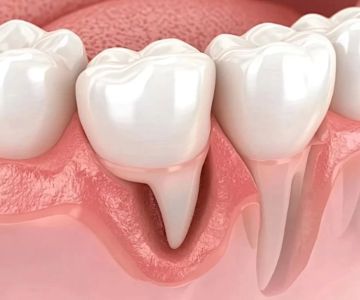How to Tell if Your Tooth is Dying: Signs and Symptoms to Look Out For
- 1. Understanding Tooth Damage
- 2. Common Signs of a Dying Tooth
- 3. Why Teeth Die and the Causes
- 4. How to Treat a Dying Tooth
- 5. When to Visit a Dentist for Tooth Problems
1. Understanding Tooth Damage
Tooth damage can occur due to various factors, including injury, decay, or infection. While it’s common for teeth to face some level of wear and tear over time, certain situations can lead to a tooth becoming “dead” or dying. A dying tooth is often the result of severe trauma or untreated decay, leading to the pulp, or nerve, inside the tooth becoming damaged beyond repair. Once the pulp is compromised, the tooth can start showing signs of infection or may eventually fall out if not addressed.
It's essential to recognize the signs of a dying tooth early to prevent further complications like infections that may affect surrounding teeth or spread to other parts of your body.
2. Common Signs of a Dying Tooth
There are several indicators that can point to a dying or dead tooth. Recognizing these signs early can help you seek treatment before the situation worsens. Some of the common symptoms include:
- Severe Tooth Pain: One of the earliest and most noticeable signs of a dying tooth is intense, persistent pain, which can be sharp or throbbing. This pain may worsen when chewing or drinking hot or cold beverages.
- Discoloration: A dying tooth may change color, often turning darker or yellowish. This happens because the nerve inside the tooth is no longer healthy, and the blood flow is affected.
- Swelling and Tenderness: The area around the affected tooth may become swollen and tender, indicating that an infection is present. In some cases, a visible abscess or pimple-like bump on the gums can form.
- Bad Breath: Foul-smelling breath or a bad taste in the mouth can be caused by infection within the tooth or surrounding gums.
- Loose Tooth: As the tooth dies, it may become loose, especially if the infection has spread to the surrounding bone structure.
If you notice any of these symptoms, it is important to contact a dentist as soon as possible to prevent further damage or infection.
3. Why Teeth Die and the Causes
Teeth can die for several reasons, with the most common causes being:
- Untreated Tooth Decay: When cavities are left untreated, they can penetrate deep into the tooth, reaching the pulp. This can result in infection or necrosis of the tooth nerve.
- Trauma or Injury: A significant blow or trauma to a tooth, such as from an accident or sports injury, can damage the pulp, causing the tooth to die if not treated promptly.
- Infection: Bacteria can infiltrate the tooth pulp, leading to infection, severe pain, and ultimately, tooth death if not addressed with root canal therapy or other treatments.
- Advanced Gum Disease: Gum disease can affect the surrounding tissues and bones, leading to tooth instability and, in some cases, tooth death due to lack of blood flow.
Understanding these causes can help you take proactive steps to protect your teeth and address issues before they lead to tooth death.
4. How to Treat a Dying Tooth
If your dentist diagnoses a dying tooth, the treatment options will depend on the severity of the issue. Common treatments for a dying tooth include:
- Root Canal Therapy: A root canal is the most common treatment for a dying tooth. It involves removing the infected or dead pulp from the tooth and sealing it to prevent further infection.
- Tooth Extraction: In severe cases where the tooth cannot be saved, it may need to be extracted to prevent the infection from spreading to surrounding teeth and tissues.
- Dental Crown: After a root canal, a crown may be placed over the tooth to restore its strength and appearance.
Early intervention is key to saving a dying tooth, so seek dental care as soon as possible if you notice any symptoms of tooth death.
5. When to Visit a Dentist for Tooth Problems
It’s important to visit your dentist regularly for checkups and if you experience any of the following signs:
- Persistent tooth pain or sensitivity
- Visible discoloration of the teeth
- Swelling or abscesses around a tooth
- Loose teeth or changes in bite
Dental professionals can diagnose the underlying issue and recommend the appropriate treatment to prevent further damage or complications.
If you’re experiencing symptoms of a dying tooth, don’t wait for the situation to worsen. Seeking prompt treatment can save your tooth and restore your smile.







 Westgate Dental Arts
Westgate Dental Arts Coventry Family Dental
Coventry Family Dental Familia Dental
Familia Dental Dr. Daniel S. Fife, DDS
Dr. Daniel S. Fife, DDS Dentistry At Suburban Square: Michael I. Wollock, DMD
Dentistry At Suburban Square: Michael I. Wollock, DMD Comfort Care Dental
Comfort Care Dental The Importance of Oral Health Education During Pregnancy for a Healthy Pregnancy
The Importance of Oral Health Education During Pregnancy for a Healthy Pregnancy Why Skipping Dental Checkups Can Lead to Bigger Oral Health Problems
Why Skipping Dental Checkups Can Lead to Bigger Oral Health Problems Advantages of Porcelain Dental Restorations
Advantages of Porcelain Dental Restorations Best Tips for Brushing Your Teeth Properly for Healthy Gums: Essential Techniques for Oral Health
Best Tips for Brushing Your Teeth Properly for Healthy Gums: Essential Techniques for Oral Health How Can Diabetes Cause Tooth and Gum Problems? Preventing and Managing Oral Health Issues
How Can Diabetes Cause Tooth and Gum Problems? Preventing and Managing Oral Health Issues Healthy Habits for Promoting Good Oral Health and Hygiene: Tips for a Healthy Smile
Healthy Habits for Promoting Good Oral Health and Hygiene: Tips for a Healthy Smile